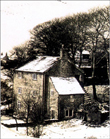
The Mills of Mellor

 Until the middle of the 18th Century Spinning and Weaving were domestic industries carried out in the home in the Mellor area. In the 1760s however, the situation changed dramatically with the coming of industrialisation. The power of fast flowing water, harnessed in both flowing in and flowing out, freely available in the local river valleys, proved immensley successful. By the 1780s the population of the Parish had risen to a peak of 3,000, with 70% of those working in textiles.
Until the middle of the 18th Century Spinning and Weaving were domestic industries carried out in the home in the Mellor area. In the 1760s however, the situation changed dramatically with the coming of industrialisation. The power of fast flowing water, harnessed in both flowing in and flowing out, freely available in the local river valleys, proved immensley successful. By the 1780s the population of the Parish had risen to a peak of 3,000, with 70% of those working in textiles.Built around 1790 it was enlarged in 1850 enlarged and employed over 150 people. The site included Mill Owners Houses, Workers Cottages and a Sunday School. It ceased working in the early 1900s and was derelict by 1930s.
 Primrose Mill
Was built as a Fulling Mill in 1780, enlarged in the 1820s and used as a Cotton Spinning Mill and spinning yarn 19c, then eventually used for Spinning and Weaving Gas Mantles. Burnt down in 1961
Primrose Mill
Was built as a Fulling Mill in 1780, enlarged in the 1820s and used as a Cotton Spinning Mill and spinning yarn 19c, then eventually used for Spinning and Weaving Gas Mantles. Burnt down in 1961
 Spade Forge
Spade Forge was working in the early 1700s and was used to make spades and pickaxes, now houses workshops, a small museum and offers Bed and Breakfast
Longshaw Clough Dam
was owned by Wiiliam Radcliffe, who was born in Mellor and a big name in the textile industry
In his heyday he employed over 1000 hand loom weavers
In his heyday he employed over 1000 hand loom weavers
Dove Bank Mills
Two big fires in 1870 destroyed what was left of most of buildings owned by the Waller Brothers,
who were known in the area for textiles, chapels, religion and a certain notoriety.
who were known in the area for textiles, chapels, religion and a certain notoriety.
Bierleys Mill
Originally a Woolen Mill, now just the remaining of one corner has been left standing and is used as a Farm Barn

Damstead Mills
comprised of two mills built by early 1800s

Catarct Mill
Old Mill Marple Bridge


Mellor Mill
The most famous mill in the area, Mellor Mill was built by Samual Oldknow between 1790-92. The biggest building of its kind in the North West at 400 feet long and 6 stories high, on the site of the modern day Roman Lakes. In addition to the Mill itself the site incorporated Mill owners houses, workers housing, ponds and gas works. It was originally used to manufacture muslins but later used for spinning yarns, finally destroyed by a fire in the 1890s.
See also excellent article on the history of Mellor Mill on the Marple website








